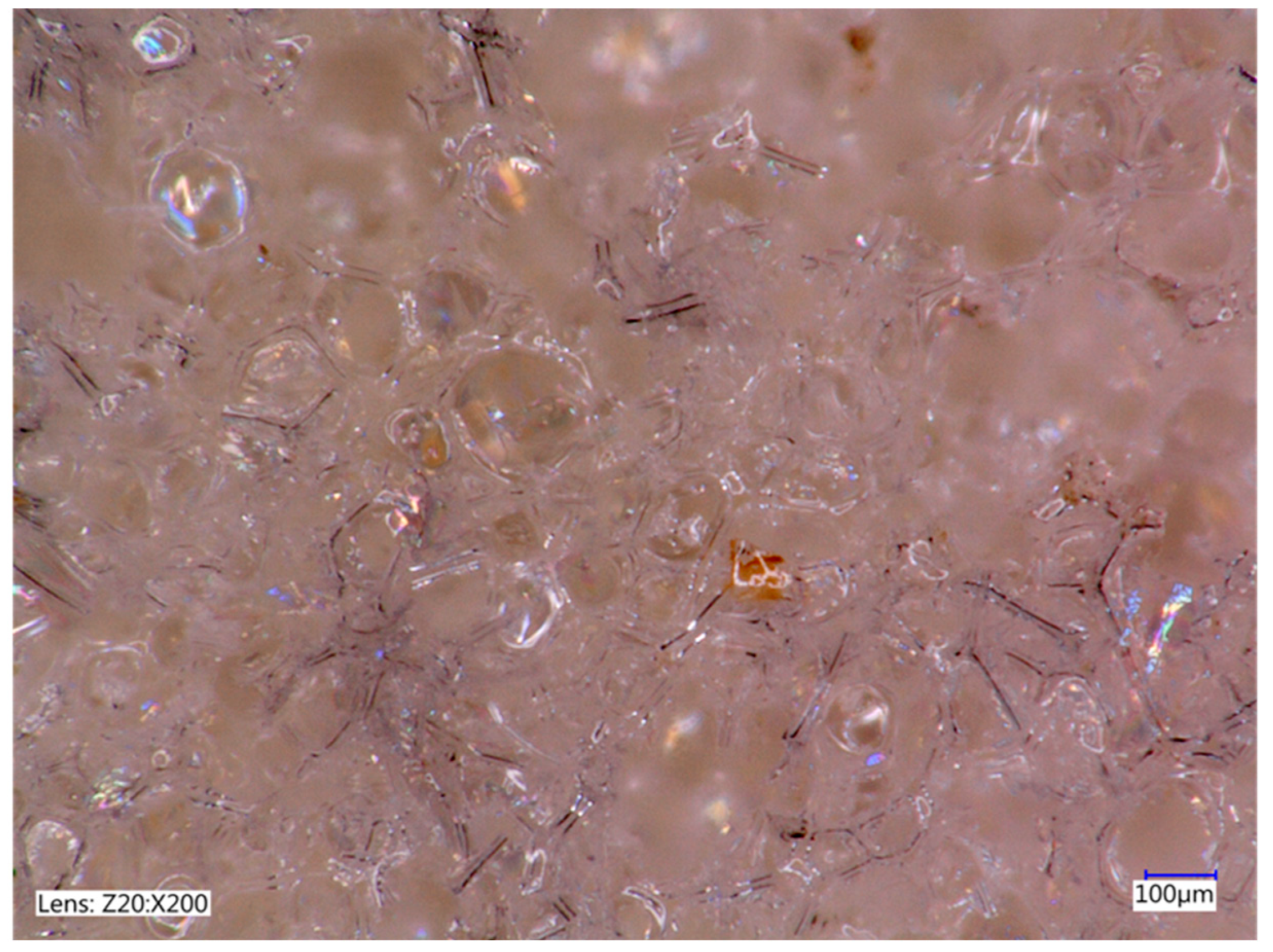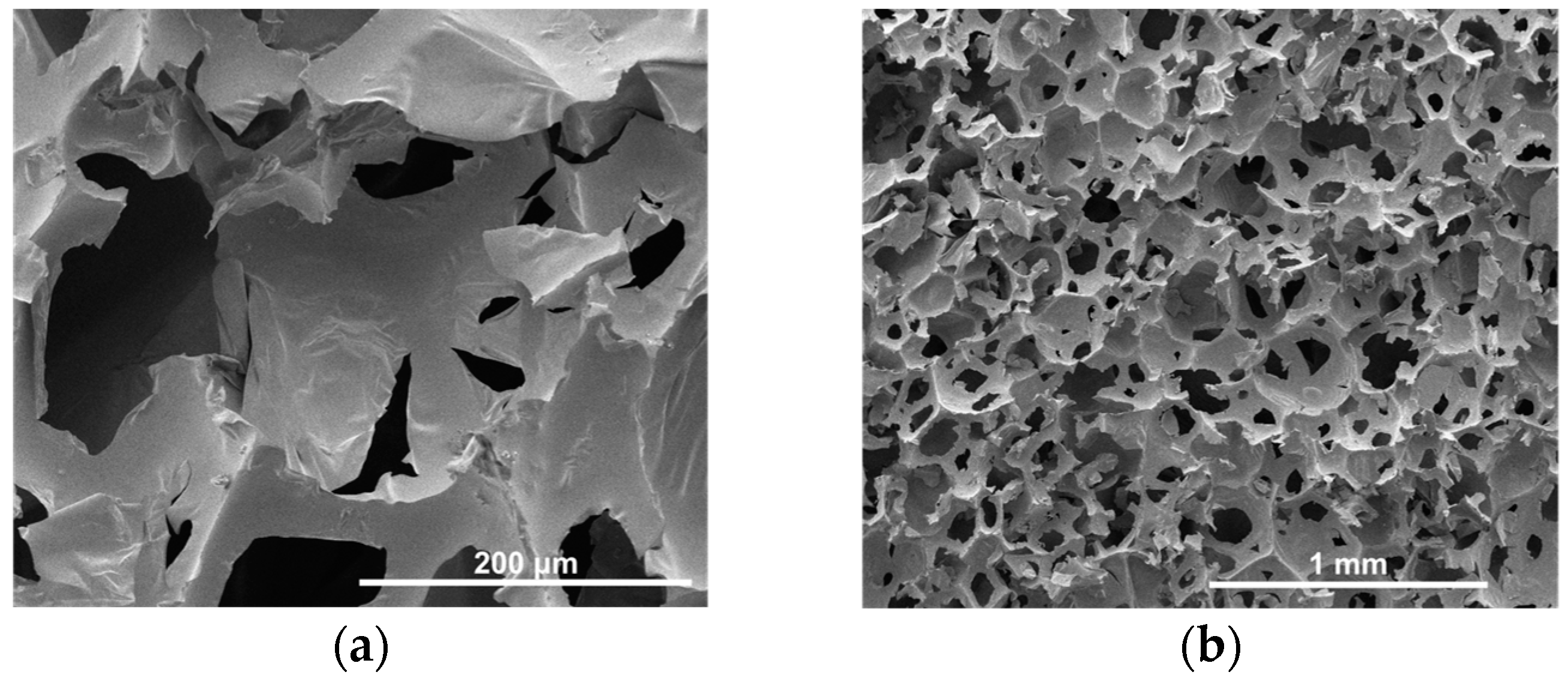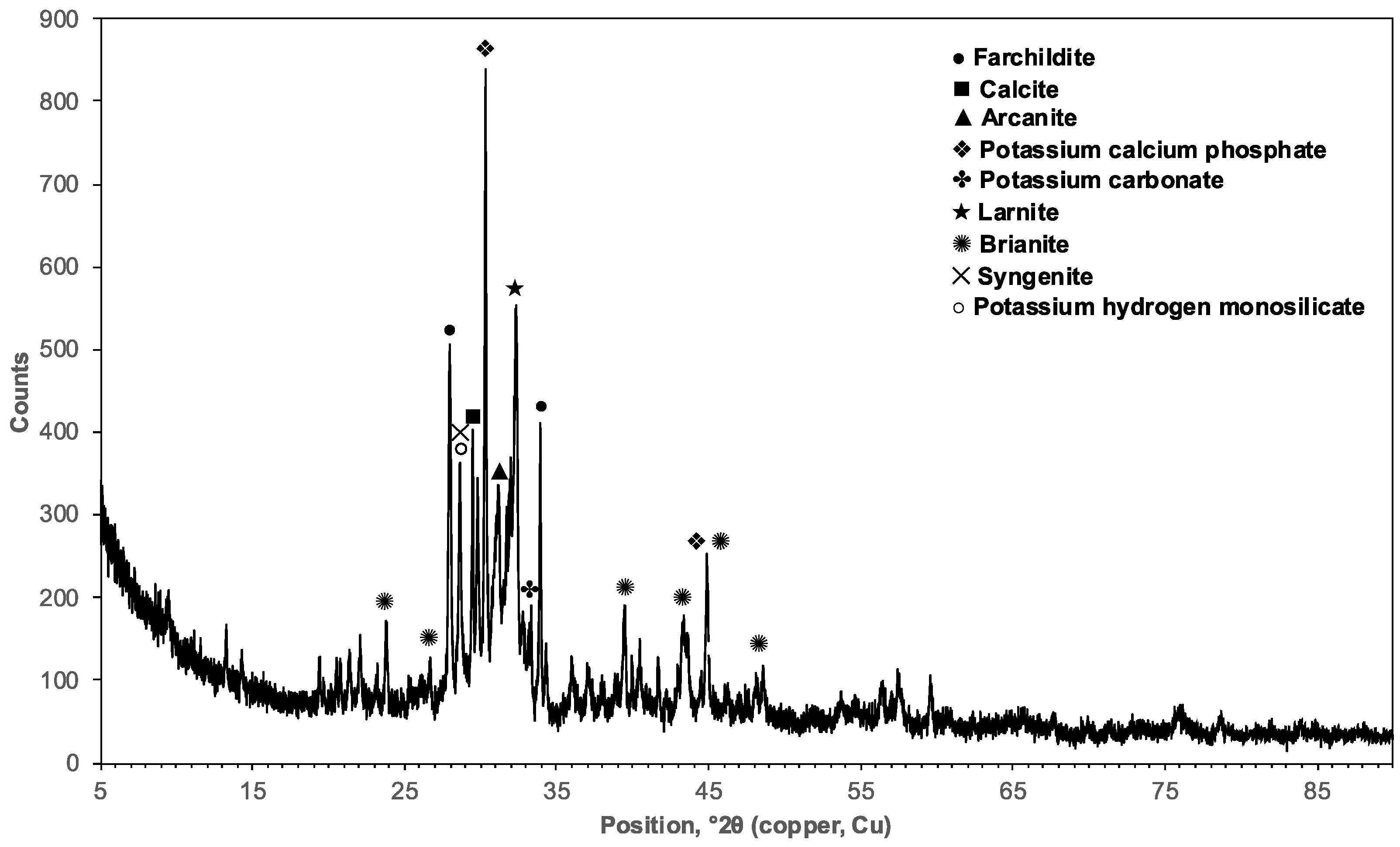Rigid Polyurethane Foams Modified with Soybean-Husk-Derived Ash as Potential Insulating Materials
Abstract
:1. Introduction
2. Materials and Methods
3. Results
3.1. Cellular Structure
3.2. Chemical Structure
3.3. Mechanical Properties and Wettability Analysis
4. Discussion
5. Conclusions
Author Contributions
Funding
Data Availability Statement
Acknowledgments
Conflicts of Interest
References
- Li, X.; Li, J.; Wang, J.; Yuan, J.; Jiang, F.; Yu, X.; Xiao, F. Recent applications and developments of Polyurethane materials in pavement engineering. Constr. Build. Mater. 2021, 304, 124639. [Google Scholar] [CrossRef]
- Wang, S.; Yang, X.; Li, Z.; Xu, X.; Liu, H.; Wang, D.; Min, H.; Shang, S. Novel eco-friendly maleopimaric acid based polysiloxane flame retardant and application in rigid polyurethane foam. Compos. Sci. Technol. 2020, 198, 108272. [Google Scholar] [CrossRef]
- Pagacz, J.; Hebda, E.; Michałowski, S.; Ozimek, J.; Sternik, D.; Pielichowski, K. Polyurethane foams chemically reinforced with POSS—Thermal degradation studies. Thermochim. Acta 2016, 642, 95–104. [Google Scholar] [CrossRef]
- Zhou, Y.; Bu, R.; Yi, L.; Sun, J. Heat transfer mechanism of concurrent flame spread over rigid polyurethane foam: Effect of ambient pressure and inclined angle. Int. J. Therm. Sci. 2020, 155, 106403. [Google Scholar] [CrossRef]
- Stanzione, M.; Russo, V.; Oliviero, M.; Verdolotti, L.; Sorrentino, A.; di Serio, M.; Tesser, R.; Iannace, S.; Lavorgna, M. Synthesis and characterization of sustainable polyurethane foams based on polyhydroxyls with different terminal groups. Polymer 2018, 149, 134–145. [Google Scholar] [CrossRef]
- Członka, S.; Strąkowska, A.; Strzelec, K.; Kairyte, A.; Vaitkus, S. Composites of rigid polyurethane foams and silica powder filler enhanced with ionic liquid. Polym. Test. 2019, 75, 12–25. [Google Scholar] [CrossRef]
- Zhang, L.; Zhang, M.; Zhou, Y.; Hu, L. The study of mechanical behavior and flame retardancy of castor oil phosphate-based rigid polyurethane foam composites containing expanded graphite and triethyl phosphate. Polym. Degrad. Stab. 2013, 98, 2784–2794. [Google Scholar] [CrossRef]
- Zatorski, W.; Brzozowski, Z.K.; Kolbrecki, A. New developments in chemical modification of fire-safe rigid polyurethane foams. Polym. Degrad. Stab. 2008, 93, 2071–2076. [Google Scholar] [CrossRef]
- Członka, S.; Sienkiewicz, N.; Strąkowska, A.; Strzelec, K. Keratin feathers as a filler for rigid polyurethane foams on the basis of soybean oil polyol. Polym. Test. 2018, 72, 32–45. [Google Scholar] [CrossRef]
- Qian, L.; Li, L.; Chen, Y.; Xu, B.; Qiu, Y. Quickly self-extinguishing flame retardant behavior of rigid polyurethane foams linked with phosphaphenanthrene groups. Compos. Part B 2019, 175, 107186. [Google Scholar] [CrossRef]
- Baek, S.H.; Kim, J.H. Polyurethane composite foams including silicone-acrylic particles for enhanced sound absorption via increased damping and frictions of sound waves. Compos. Sci. Technol. 2020, 198, 108325. [Google Scholar] [CrossRef]
- Da Silva, V.R.; Mosiewicki, M.A.; Yoshida, M.I.; da Silva, M.C.; Stefani, P.M.; Marcovich, N.E. Polyurethane foams based on modified tung oil and reinforced with rice husk ash II: Mechanical characterization. Polym. Test. 2013, 32, 665–672. [Google Scholar] [CrossRef]
- Kuźnia, M.; Magiera, A.; Pielichowska, K.; Ziąbka, M.; Benko, A.; Szatkowski, P.; Jerzak, W. Fluidized bed combustion fly ash as filler in composite polyurethane materials. Waste Manag. 2019, 92, 115–123. [Google Scholar] [CrossRef]
- Kuźnia, M.; Magiera, A.; Zygmunt-Kowalska, B.; Kaczorek-Chrobak, K.; Pielichowska, K.; Szatkowski, P.; Benko, A.; Ziąbka, M.; Jerzak, W. Fly ash as an eco-friendly filler for rigid polyurethane foams modification. Materials 2021, 14, 6604. [Google Scholar] [CrossRef] [PubMed]
- Igliński, B.; Pietrzak, M.B.; Kiełkowska, U.; Skrzatek, M.; Kumar, G.; Piechota, G. The assessment of renewable energy in Poland on the background of the world renewable energy sector. Energy 2022, 261, 125319. [Google Scholar] [CrossRef]
- Jankowski, K.J.; Sokolski, M.; Szatkowski, A.; Kozak, M. Crambe—Energy efficiency of biomass production and mineral fertilization. A case study in Poland. Ind. Crops Prod. 2022, 182, 114918. [Google Scholar] [CrossRef]
- Dzikuć, M.; Gorączkowska, J.; Piwowar, A.; Dzikuć, M.; Smoleński, R.; Kułyk, P. The analysis of the innovative potential of the energy sector and low-carbon development: A case study for Poland. Energy Strategy Rev. 2021, 38, 100769. [Google Scholar] [CrossRef]
- Asefnejad, A.; Khorasani, M.T.; Behnamghader, A.; Farsadzadeh, B.; Bonakdar, S. Manufacturing of biodegradable polyurethane scaffolds based on polycaprolactone using a phase separation method: Physical properties and in vitro assay. Int. J. Nanomed. 2011, 6, 2375. [Google Scholar] [CrossRef]
- Husainie, S.M.; Deng, X.; Ghalia, M.A.; Robinson, J.; Naguib, H.E. Natural fillers as reinforcement for closed-molded polyurethane foam plaques: Mechanical, morphological, and thermal properties. Mater. Today Commun. 2021, 27, 102187. [Google Scholar] [CrossRef]
- Stancin, H.; Mikulcić, H.; Manić, N.; Stojiljiković, D.; Vujanović, M.; Wang, X.; Duić, N. Thermogravimetric and kinetic analysis of biomass and polyurethane foam mixtures co-pyrolysis. Energy 2021, 237, 121592. [Google Scholar] [CrossRef]
- Pereira, R.C.; Felipe, V.T.A.; Avelino, F.; Mattos, A.L.; Mazzetto, S.E.; Lomonaco, D. From biomass to eco-friendly composites: Polyurethanes based on cashew nutshell liquid reinforced with coconut husk fiber. Biomass Convers. Biorefin. 2022. [Google Scholar] [CrossRef]
- Ramachandran, A.; Mavinkere Rangappa, S.; Kushvaha, V.; Khan, A.; Seingchin, S.; Dhakal, H.N. Modification of fibers and matrices in natural fiber reinforced polymer composites: A comprehensive review. Macromol. Rapid Commun. 2022, 43, 2100862. [Google Scholar] [CrossRef]
- Asim, M.; Paridah, M.T.; Chandrasekar, M.; Shahroze, R.M.; Jawaid, M.; Nasir, M.; Siakeng, R. Thermal stability of natural fibers and their polymer composites. Iran. Polym. J. 2020, 29, 625–648. [Google Scholar] [CrossRef]
- Malani, R.S.; Malshe, V.C.; Thorat, B.N. Polyols and polyurethanes from renewable sources: Past, present, and future—Part 2: Plant-derived materials. J. Coat. Technol. Res. 2022, 19, 361–375. [Google Scholar] [CrossRef]
- Malani, R.S.; Malshe, V.C.; Thorat, B.N. Polyols and polyurethanes from renewable sources: Past, present and future—Part 1: Vegetable oils and lignocellulosic biomass. J. Coat. Technol. Res. 2022, 19, 201–222. [Google Scholar] [CrossRef]
- Cabrera, F.C. Eco-friendly polymer composites: A review of suitable methods for waste management. Polym. Compos. 2021, 42, 2653–2677. [Google Scholar] [CrossRef]
- Jasiunas, L.; Peck, G.; Bridziuviene, D.; Miknius, L. Mechanical, thermal properties and stability of high renewable content liquefied residual biomass derived bio-polyurethane wood adhesives. Int. J. Adhes. Adhes. 2020, 101, 102618. [Google Scholar] [CrossRef]
- Jasiunas, L.; McKenna, S.T.; Bridziuviene, D.; Miknius, L. Mechanical, thermal properties and stability of rigid polyurethane foams produced with crude-glycerol derived biomass biopolyols. J. Polym. Environ. 2020, 28, 1378–1389. [Google Scholar] [CrossRef]
- Zhang, J.; Hori, N.; Takemura, A. Effect of natural biomass fillers on the stability, degradability, and elasticity of crop straws liquefied polyols-based polyurethane foams. J. Appl. Polym. Sci. 2023, 140, e53324. [Google Scholar] [CrossRef]
- Olszewski, A.; Kosmela, P.; Piszczyk, Ł. Synthesis and characterization of bio-polyols through biomass liquefaction of wood shavings and their application in the preparation of polyurethane wood composites. Eur. J. Wood Wood Prod. 2021, 80, 57–74. [Google Scholar] [CrossRef]
- Kairyte, A.; Kremensas, A.; Vaitkus, S.; Członka, S.; Strąkowska, A. Fire suppression and thermal behavior of biobased rigid polyurethane foam filled with biomass incineration waste ash. Polymers 2020, 12, 683. [Google Scholar] [CrossRef]
- Kairyte, A.; Kizinievic, O.; Kizinievic, V.; Kremensas, A. Synthesis of biomass-derived bottom waste ash based rigid biopolyurethane composite foams: Rheological behaviour, structure and performance characteristics. Compos. Part A 2019, 117, 193–201. [Google Scholar] [CrossRef]
- Hejna, A.; Kopczyńska, M.; Kozłowska, U.; Klein, M.; Kosmela, P.; Piszczyk, Ł. Foamed polyurethane composites with different types of ash–morphological, mechanical and thermal behavior assessments. Cell. Polym. 2016, 35, 287–308. [Google Scholar] [CrossRef]
- Hejna, A.; Kosmela, P.; Mikicka, M.; Danowska, M.; Piszczyk, Ł. Modification of microporous polyurethane elastomers with different types of ash—Morphological, mechanical, and thermal studies. Polym. Compos. 2016, 37, 881–889. [Google Scholar] [CrossRef]
- Chi, J.; Zhang, Y.; Tu, F.; Sun, J.; Zhi, H.; Yang, J. The synergistic flame-retardant behaviors of soybean oil phosphate-based polyols and modified ammonium polyphosphate in polyurethane foam. J. Polym. Res. 2023, 30, 84. [Google Scholar] [CrossRef]
- Biazatti, M.J.; de Carvalho Miranda, J.C. Soybean-based concept biorefinery. Biofuels, Bioprod. Biorefin. 2021, 15, 980–1005. [Google Scholar] [CrossRef]
- Supić, S.; Malesev, M.; Radonjanin, V.; Bulatović, V.; Milović, T. Reactivity and pozzolanic properties of biomass ashes generated by wheat and soybean straw combustion. Materials 2021, 14, 1004. [Google Scholar] [CrossRef]
- Gupta, N.; Mahur, B.K.; Izrayeel, A.M.D.; Ahuja, A.; Rastogi, V.K. Biomass conversion of agricultural waste residues for different applications: A comprehensive review. Environ. Sci. Pollut. Res. 2022, 29, 73622–73647. [Google Scholar] [CrossRef]
- EN ISO 18122:2016; Standard Solid Biofuels–Determination of ash Content. Available online: https://sklep.pkn.pl/pn-en-iso-18122-2016-01p.html (accessed on 28 November 2022).
- ASTM D1622-03; Standard Test Method for Apparent Density of Rigid Cellular Plastics. Available online: https://www.astm.org/d1622-03.html (accessed on 28 November 2022).
- Trovati, G.; Sanches, E.A.; Neto, S.C.; Mascarenhas, Y.P.; Chierice, G.O. Characterization of polyurethane resins by FTIR, TGA, and XRD. J. Appl. Polym. Sci. 2010, 115, 263–268. [Google Scholar] [CrossRef]
- Gujral, P.; Varshney, S.; Dhawan, S. Designing of multiphase fly ash/MWCNT/PU composite sheet against electromagnetic environmental pollution. J. Electron. Mater. 2016, 45, 3142–3148. [Google Scholar] [CrossRef]
- Kalembkiewicz, J.; Galas, D.; Sitarz-Palczak, E. The physicochemical properties and composition of biomass ash and evaluating directions of its applications. Pol. J. Environ. Stud. 2018, 27, 6. [Google Scholar] [CrossRef]
- Vaiciukyniene, D.; Nizeviciene, D.; Kantautas, A.; Kiele, A.; Bocullo, V. Alkali activated binders based on biomass bottom ash and silica by-product blends. Waste Biomass Valorization 2021, 12, 1095–1105. [Google Scholar] [CrossRef]
- Skevi, L.; Baki, V.A.; Feng, Y.; Valderrabano, M.; Ke, X. Biomass bottom ash as supplementary cementitious material: The effect of mechanochemical pre-treatment and mineral carbonation. Materials 2022, 15, 8357. [Google Scholar] [CrossRef] [PubMed]
- Trivedi, N.S.; Mandavgane, S.A.; Mehetre, S.; Kulkarni, B.D. Characterization and valorization of biomass ashes. Environ. Sci. Pollut. Res. 2016, 23, 20243–20256. [Google Scholar] [CrossRef]
- Ke, X.; Baki, V.A.; Skevi, L. Mechanochemical activation for improving the direct mineral carbonation efficiency and capacity of a timber biomass ash. J. CO2 Util. 2023, 68, 102367. [Google Scholar] [CrossRef]
- Yu, H.; Lei, Y.; Yu, X.; Wang, X.; Liu, T.; Luo, S. Batch foaming of carboxylated multiwalled carbon nanotube/poly(ether imide) nanocomposites: The influence of the carbon nanotube aspect ratio on the cellular morphology. J. Appl. Polym. Sci. 2015, 132, 42325. [Google Scholar] [CrossRef]
- Yu, H.; Lei, Y.; Yu, X.; Wang, X.; Liu, T.; Luo, S. Solid-state polyetherimide (PEI) nanofoams: The influence of the compatibility of nucleation agent on the cellular morphology. J. Polym. Res. 2016, 23, 121. [Google Scholar] [CrossRef]
- Pérez-Tamarit, S.; Solórzano, E.; Mokso, R.; Rodríguez-Perez, M.A. In-situ understanding of pore nucleation and growth in polyurethane foams by using real-time synchrotron X-ray tomography. Polymer 2019, 166, 50–54. [Google Scholar] [CrossRef]
- Usta, N. Investigation of fire behavior of rigid polyurethane foams containing fly ash and intumescent flame retardant by using a cone calorimeter. J. Appl. Polym. Sci. 2012, 124, 3372–3382. [Google Scholar] [CrossRef]
- Tarakcılar, A.R. The effects of intumescent flame retardant including ammonium polyphosphate/pentaerythritol and fly ash fillers on the physicomechanical properties of rigid polyurethane foams. J. Appl. Polym. Sci. 2011, 120, 2095–2102. [Google Scholar] [CrossRef]
- Cao, X.; Lee, L.J.; Widya, T.; Macosko, C. Polyurethane/clay nanocomposites foams: Processing, structure and properties. Polymer 2005, 46, 775–783. [Google Scholar] [CrossRef]
- Madaleno, L.; Pyrz, R.; Crosky, A.; Jensen, L.R.; Rauhe, J.C.M.; Dolomanova, V.; de Barros, A.M.M.V.; Pinto, J.J.C.; Norman, J. Processing and characterization of polyurethane nanocomposite foam reinforced with montmorillonite–carbon nanotube hybrids. Compos. Part A 2013, 44, 1–7. [Google Scholar] [CrossRef]
- Paciorek-Sadowska, J.; Czupryński, B.; Borowicz, M.; Liszkowska, J. Rigid polyurethane–polyisocyanurate foams modified with grain fraction of fly ashes. J. Cell. Plast. 2020, 56, 53–72. [Google Scholar] [CrossRef]
- Strąkowska, A.; Członka, S.; Miedzińska, K.; Strzelec, K. Rigid polyurethane foams with antibacterial properties modified with pine oil. Polimery 2020, 65, 691–697. [Google Scholar] [CrossRef]
- Shi, H.; Shi, D.; Yin, L.; Yang, Z.; Luan, S.; Gao, J.; Zha, J.; Yin, J.; Li, R.K. Ultrasonication assisted preparation of carbonaceous nanoparticles modified polyurethane foam with good conductivity and high oil absorption properties. Nanoscale 2014, 6, 13748–13753. [Google Scholar] [CrossRef] [PubMed]
- Ng, Z.C.; Roslan, R.A.; Lau, W.J.; Gursoy, M.; Karaman, M.; Jullok, N.; Ismail, A.F. A green approach to modify surface properties of polyurethane foam for enhanced oil absorption. Polymers 2020, 12, 1883. [Google Scholar] [CrossRef] [PubMed]
- Huang, P.; Wu, F.; Shen, B.; Zheng, H.; Ren, Q.; Luo, H.; Zheng, W. Biomimetic porous polypropylene foams with special wettability properties. Compos. Part B 2020, 190, 107927. [Google Scholar] [CrossRef]
- Li, H.; Lin, S.; Feng, X.; Pan, Q. Preparation of superhydrophobic and superoleophilic polyurethane foam for oil spill cleanup. J. Macromol. Sci. Part A Pure Appl. Chem. 2021, 58, 758–768. [Google Scholar] [CrossRef]







| Sample Name | Vertical Feret Diameter, µm | Horizontal Feret Diameter, µm | Strut Thickness, µm |
|---|---|---|---|
| PUR + 5%A | 95 ± 5 | 98 ± 4 | 10.5 ± 0.6 |
| PUR + 10%A | 71 ± 11 | 63 ± 9 | 12.9 ± 0.5 |
| PUR + 15%A | 77 ± 5 | 75 ± 4 | 11.2 ± 0.5 |
| PUR + 20%A | 79 ± 6 | 85 ± 6 | 10.7 ± 0.4 |
| Oxide Composition | Fraction, % | Crystal Phases |
|---|---|---|
| Cao | 39.2 | Fairchildite K2Ca(CO3)2 |
| K2O | 34.2 | Calcite CaCO3 |
| P2O5 | 17.1 | Arcanite K2SO4 |
| MgO | 5.6 | Potassium calcium phosphate KCaPO4 |
| SO3 | 1.5 | Potassium carbonate K2CO3 |
| SiO2 | 1.1 | Larnite Ca2SiO4 |
| Fe2O3 | 0.5 | Brianite Na2CaMg(PO4)2 |
| Al2O3 | 0.4 | Syngenite K2Ca(SO4)2·H2O |
| Na2O | 0.1 | Potassium hydrogen monosilicate KHSiO3 |
| MnO | 0.1 |
| Sample Name | Apparent Density d, kg m−3 | Compressive Strength Rm, kPa | Young’s Modulus E, MPa |
|---|---|---|---|
| PUR + 5%A | 41 ± 1 | 148 ± 19 | 1.9 ± 0.5 |
| PUR + 10%A | 37 ± 1 | 135 ± 13 | 2.4 ± 0.3 |
| PUR + 15%A | 46 ± 2 | 128 ± 27 | 2.5 ± 0.6 |
| PUR + 20%A | 55 ± 5 | 142 ± 43 | 2.9 ± 0.4 |
| Sample Name | Contact Angle in H2O, ° | Contact Angle in C2H2I2, ° | SFE Total, mN m−1 | SFE Disperse, mN m−1 | SFE Polar, mN m−1 |
|---|---|---|---|---|---|
| PUR + 5%A | 106.3 ± 1.9 | 64.1 ± 7.4 | 26.3 ± 4.5 | 26.2 ± 4.3 | 0.1 ± 0.2 |
| PUR + 10%A | 119.3 ± 4.4 | 93.6 ± 1.1 | 11.3 ± 0.7 | 11.2 ± 0.5 | 0.2 ± 0.3 |
| PUR + 15%A | 131.6 ± 1.4 | 88.0 ± 4.4 | 14.1 ± 2.3 | 13.6 ± 2.0 | 0.5 ± 0.3 |
| PUR + 20%A | 151.2 ± 5.2 | 92.1 ± 5.6 | 14.4 ± 3.4 | 11.8 ± 2.4 | 2.6 ± 1.0 |
Disclaimer/Publisher’s Note: The statements, opinions and data contained in all publications are solely those of the individual author(s) and contributor(s) and not of MDPI and/or the editor(s). MDPI and/or the editor(s) disclaim responsibility for any injury to people or property resulting from any ideas, methods, instructions or products referred to in the content. |
© 2023 by the authors. Licensee MDPI, Basel, Switzerland. This article is an open access article distributed under the terms and conditions of the Creative Commons Attribution (CC BY) license (https://creativecommons.org/licenses/by/4.0/).
Share and Cite
Magiera, A.; Kuźnia, M.; Błoniarz, A.; Magdziarz, A. Rigid Polyurethane Foams Modified with Soybean-Husk-Derived Ash as Potential Insulating Materials. Processes 2023, 11, 3416. https://doi.org/10.3390/pr11123416
Magiera A, Kuźnia M, Błoniarz A, Magdziarz A. Rigid Polyurethane Foams Modified with Soybean-Husk-Derived Ash as Potential Insulating Materials. Processes. 2023; 11(12):3416. https://doi.org/10.3390/pr11123416
Chicago/Turabian StyleMagiera, Anna, Monika Kuźnia, Aleksandra Błoniarz, and Aneta Magdziarz. 2023. "Rigid Polyurethane Foams Modified with Soybean-Husk-Derived Ash as Potential Insulating Materials" Processes 11, no. 12: 3416. https://doi.org/10.3390/pr11123416





